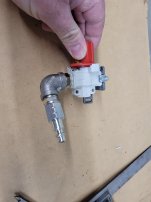kb0thn
Stainless
- Joined
- May 15, 2008
- Location
- Winona, MN, USA
I am doing pneumatic maintenance and repair on a 2000 vintage German made CNC router. Pneumatic fittings are all BSPP which I understand to be a straight thread that requires an o-ring on the face to seal. I guess these are now called "G" thread, which Parker says stands for "global". Fittings are mostly 1/4" with some 3/8" and 1/8".
Question: How the heck are you supposed to put fittings together into a given orientation and have them compress the o-ring enough to seal? On some it magically lines up. On others I am 1/2 a rotation away from where I need to be by the time the bodies bottom out on the metal washer surrounding the o-ring. With putting the fragile looking part in a bench vise and using a 8" long wrench I can get another 3/8 of a turn tighter before things are *really* bottomed out and I am about to break something.
It appears that somebody before me dealt with this by using various thread sealants and goops on the threads like I would expect to see on tapered threads. They skipped the o-rings all together. Is this the right way?
Thanks,
-Jim
Question: How the heck are you supposed to put fittings together into a given orientation and have them compress the o-ring enough to seal? On some it magically lines up. On others I am 1/2 a rotation away from where I need to be by the time the bodies bottom out on the metal washer surrounding the o-ring. With putting the fragile looking part in a bench vise and using a 8" long wrench I can get another 3/8 of a turn tighter before things are *really* bottomed out and I am about to break something.
It appears that somebody before me dealt with this by using various thread sealants and goops on the threads like I would expect to see on tapered threads. They skipped the o-rings all together. Is this the right way?
Thanks,
-Jim






